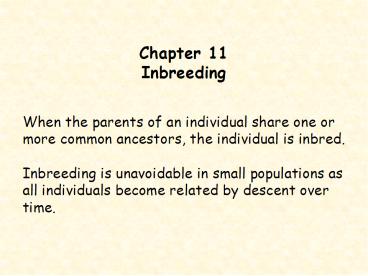The consequence of matings between relatives is - PowerPoint PPT Presentation
1 / 26
Title:
The consequence of matings between relatives is
Description:
3.9% for Isle Royale wolves compared to 8.7% for a captive ... Gray wolves suffer reproductive fitness due. to inbreeding -- the Isle Royale population has ... – PowerPoint PPT presentation
Number of Views:87
Avg rating:3.0/5.0
Title: The consequence of matings between relatives is
1
(No Transcript)
2
The consequence of matings between relatives is
that offspring have an increased probability of
inheriting alleles that are recent copies of the
same DNA sequence. These recent copies of the
same allele are referred to as Identical by Des
cent or Autozygous. The inbreeding coefficient
(F) is used to measure inbreeding.
3
As F is a probability, it ranges from 0 to 1.
Identity by descent is related to, but distinct
from homozygosity. Individuals carrying two al
leles identical by descent are homozygous. How
ever, not all homozygotes carry alleles that
are identical by descent -- homozygotes include
both autozygous and allozygous types.
4
Inbreeding decreases heterozygosity and
increases homozygosity thus altering genotypic
ratios from that expected based on Hardy-
Weinberg expectations. However, inbreeding does
NOT change allele frequencies. The reduction
in heterozygosity due to inbreeding
is directly related to the inbreeding
coefficient.
5
We can estimate the level of inbreeding by
comparing observed (Ho) heterozygosity with
expected (He) under random mating as follows
F 1 - (He/Ho) Effects of population size
on the level of inbreeding can be determined by c
onsidering the probability of identity by descent
in the idealized randomly mating population.
6
When the initial population is NOT inbred (F0
0), the inbreeding coefficient in any subsequent
generation t is Ft 1 - 1 -
1/2Net Thus, inbreeding accumulates with time
in all closed finite populations at a rate depend
ent upon their population size.
7
(No Transcript)
8
Indirect Estimates of Inbreeding Coefficients
In most populations, levels of inbreeding are u
nknown. However, an estimate of the average inb
reeding can be obtained from the effective inbree
ding coefficient (Fe) Fe 1 - (Ht/H0)
9
(No Transcript)
10
(No Transcript)
11
Decline could have been due to
reduced availability of prey disease deleteri
ous effects of inbreeding combination of factors
Suggested that the island population must be
inbred due to the low number of founders.
All individuals have the same rare mtDNA haplot
ype.
12
DNA fingerprint data suggests that island
wolves are as similar as sibs in a captive
population of wolves. Allozyme heterozygosity,
based on 25 loci, was 3.9 for Isle Royale wolve
s compared to 8.7 for a captive population. F
e 1 - (Hisland/Hmainland) 1 - (0.39/0.87)
0.55
13
Thus, this endangered island population is
highly inbred. Gray wolves suffer reproductive
fitness due to inbreeding -- the Isle Royale popu
lation has smaller litters and poor juvenile surv
ival!
14
Pedigree Path Analysis -- Once a pedigree of an
individual (say X) is obtained, we can
calculate its inbreeding coefficient, FX. Step
I Draw the pedigree so that the common
ancestors appear only once. A common ancestor
is any individual related to both parents of X, t
he individual for whom we wish to determine FX.
If there are no common ancestors, then FX 0
15
Step II Determine the inbreeding coefficient.
If there is no pedigree information on the commo
n ancestors, it is often assumed to be non-inbred
If the common ancestor is inbred, then its i
nbreeding coefficient, FCA, must be calculated
before calculating FX Calculate FCA as you woul
d FX as described below. Once FCA is determined
, FX can be calculated.
A
16
Step III Look for loops in the pedigree
A loop is a path that runs from X, through one
parent, to the common ancestor, through the
other parent, and back to X without going through
any individual more than once. Determine the
number of steps in each path.
17
Step IV Calculate the contribution of each
loop to the inbreeding coefficient. The contri
bution of each loop to FX is determined
as follows (1/2)i X (1 FCA) Where FCA is
the inbreeding coefficient of the
common ancestor and i is the number of steps in
each loop as defined in step III.
18
Step V Sum the contribution of each loop. The
summation of all the contributions will be the
inbreeding coefficient of individual X.
19
(No Transcript)
20
(No Transcript)
21
(No Transcript)
22
(No Transcript)
23
(No Transcript)
24
(No Transcript)
25
(No Transcript)
26
A C D G H K L M
Loop FCA i K-G-C-A-D-H-L 0.0 7 (1/2)7 0.0078
K-H-C-A-D-G-L 0.0 7 (1/2)7 0.0078
K-G-D-A-C-H-L 0.0 7 (1/2)7 0.0078
K-H-D-A-C-G-L 0.0 7 (1/2)7 0.0078
K-G-C-H-L 0.0 5 (1/2)5 0.0313
K-G-D-H-L 0.0 5 (1/2)5 0.0313
C-A-D 0.0 3 (1/2)3 0.125 C-A-D 0.0 3 (1/2)3
0.125 K-G-L 0.125 3 (1/2)3 X (1.125) 0.1406
K-H-L 0.125 3 (1/2)3 X (1.125) 0.1406
FM 0.375

